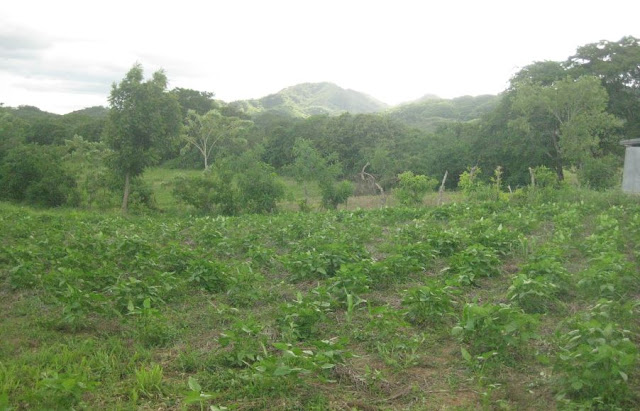Focus groups. Over three days our team carried out a total of 8 focus group meetings within four of the five municipalities that ADENOCH works in. We were gathering data on food consumption, fields, practices, and harvests and perceptions and ideas around advantages and disadvantages of the conservation agriculture approach. (thanks to Chris for sharing some of these pictures)
Field visits. The participating farmers' fields were mapped out and then we selected at random the fields that would be visited. There are around 200 participating farmers in ADENOCH's project, so we wouldn't come close to getting to all of them. I think our total was around 50, which exceeded what the evaluation framework called for. We saw quite a variety of quality in these fields - some great plots and some terrible ones as well. The conservation ag concept is basically three principles which are applied and adapted according to the resources of the region: soil moisture through ground cover, minimal soil disturbance (no till), and crop rotation. Here that has meant ground cover through leftover crop residue of corn, sesame, or something else; digging 15 cm x 15 cm x 15 cm holes that are carefully spaced and filling them with manure; and rotating corn and bean crops (and anything else if they have it). I should also mention that it was a beautiful place for hiking around these communities, and I am also completely amazed by the strength of these farmers to farm the kinds of terrain that they are working with.
One of ADENOCH's staff, Pascual (who is technically with Fundación Cristiana), in front of his own plot (across the road).
Great rains were falling the days that we were in the area. We would slip under the nearest roof to wait out the heaviest rain.
As a side note, gold is actually a significant export in Nicaragua and it's not unusual to see a mortar and pestle that folks will use to sort through soil from nearby mines.
Here's the part of the team that was staying at the hotel during the Nicaragua side of the evaluation: Denis, from another organization in Nicaragua called CEPAD; Chris, evaluation leader from Kentucky; myself; Adolfo, coordinator of the CODESO organization in Honduras. These folks, plus the ADENOCH staff on the evaluation team, were great to work with. Lots of learning!
Findings. We'll have a better sense for some of this after the "data-crunching" stage and the final report is completed. At the moment it seems that the bright side is that significantly more is being grown within the conservation ag. plots compared to an equivalent size of a conventional ag. plot. The CA plots are doing better with the low amount of rain (although they still need something) which is also really important in this area. The unfortunate side is that these conservation ag. plots are still quite small and are requiring more work than would permit a farmer to expand this practice into their entire field. In order to make a high-yield-with-little-rain method work in a farmer's full field, it looks like some more thinking and re-thinking lies ahead. Green cover crops? A role for conventional fertilizers already in use? Maybe even herbicide at times? We'll see...















No comments:
Post a Comment